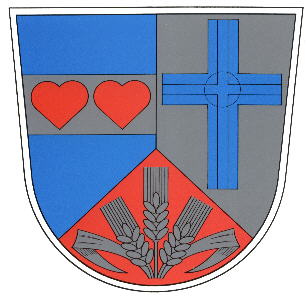Dunum: Difference between revisions
Jump to navigation
Jump to search
Knorrepoes (talk | contribs) m (Text replace - "District (Kreis) : Wittmund Samtgemeinde : Samtgemeinde Esens" to "District (Kreis) : Wittmund<br> Samtgemeinde : Samtgemeinde Esens") |
Knorrepoes (talk | contribs) m (Text replace - "[[Literature" to "{{media}} [[Literature") |
||
| Line 17: | Line 17: | ||
The arms show in the right half the (alleged) arms of the last King of the Frisians, Radbo(u)d, who, according to legend, is buried in the local Rabbelsberg and will one day ascend to unite all Frisians again. The cross in the left half symbolises the local church, dating from the 13<sup>th</sup> century. The base symbolises agriculture. | The arms show in the right half the (alleged) arms of the last King of the Frisians, Radbo(u)d, who, according to legend, is buried in the local Rabbelsberg and will one day ascend to unite all Frisians again. The cross in the left half symbolises the local church, dating from the 13<sup>th</sup> century. The base symbolises agriculture. | ||
{{media}} | |||
[[Literature]] : - | [[Literature]] : - | ||
Revision as of 20:55, 8 July 2014
| Heraldry of the World Civic heraldry of Germany - Deutsche Wappen (Gemeindewappen/Kreiswappen) |
DUNUM
State : Niedersachsen
District (Kreis) : Wittmund
Samtgemeinde : Samtgemeinde Esens
Origin/meaning
The arms show in the right half the (alleged) arms of the last King of the Frisians, Radbo(u)d, who, according to legend, is buried in the local Rabbelsberg and will one day ascend to unite all Frisians again. The cross in the left half symbolises the local church, dating from the 13th century. The base symbolises agriculture.
Contact and Support
Partners:
Your logo here ?
Contact us
© since 1995, Heraldry of the World, Ralf Hartemink 
Index of the site
Literature : -











